Chris Cooper's Blog, page 13
May 5, 2025
Beat the Summer Revenue Dip: The Gym Owner’s Action Plan
To watch this episode on YouTube, click here.
The post Beat the Summer Revenue Dip: The Gym Owner’s Action Plan appeared first on Two-Brain Business.
May 2, 2025
He Added $200,000 in Semi-Private Training Revenue in Just 1 Year!
To watch this episode on YouTube, click here.
The post He Added $200,000 in Semi-Private Training Revenue in Just 1 Year! appeared first on Two-Brain Business.
May 1, 2025
$OPs: Business Basics That Make Big Bucks
To watch this episode on YouTube, click here.
The post $OPs: Business Basics That Make Big Bucks appeared first on Two-Brain Business.
April 30, 2025
The Funnel Audit: Your Essential Marketing Checklist
“I need more leads!”
This is probably the thing I hear from gym owners most often.
Here’s the good news: You might not actually need more leads. You might just be missing the leads you already have.
A marketing “funnel” is the path a lead takes to become a client. When drawn out, the path looks like a funnel because not every lead will become a client. You might have 10 leads at the top of the funnel, five at the midway point and one who actually signs up.
Most gym owners don’t build clear marketing funnels. Most just wait and hope, “give it time,” or trust the universe to do their marketing. They say things like “we’re the best gym in town” and “our clients love us” and hope that’s enough to grow the gym.
It’s not.
You have to be deliberate about marketing.
This audit will show you where your funnels are missing pieces and where they’re leaking. And you might be missing some critical funnels altogether.
We build each of these funnels with you in the Two-Brain mentorship program and show you how to maintain them for peak flow forever.
1. The Referral Funnel
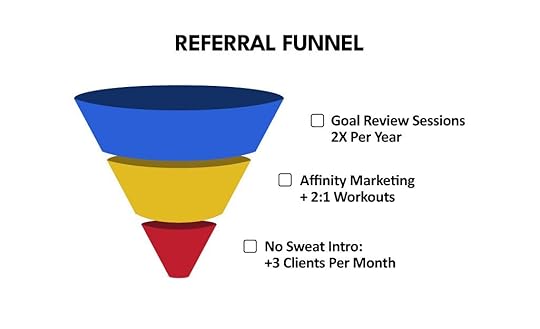
Funnel Checklist
Top: I’m booking Goal Review Sessions with all my clients at least twice per year.
Middle: I’m using Affinity Marketing to identify the best possible referral from each client and then booking that referral for a 2:1 workout.
Bottom: I’m signing up at least three clients from referrals every month using a consultative sales process.
2. The Organic Social Media Funnel
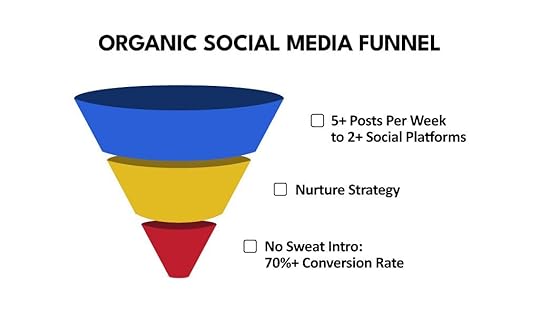
Funnel Checklist
Top: I’m posting at least five pieces of content every week to at least two platforms, such as Facebook, Instagram, TikTok or Google Business Profile. I have at least two calls to action every week.
Middle: I’m using a nurture strategy such as sell by chat or an email list to convert leads into No Sweat Intro appointments.
Bottom: I’m using a consultative sales process to convert at least 70 percent of appointments into clients.
3. The Content Funnel

Funnel Checklist
Top: I publish a podcast, blog or YouTube video at least twice per week.
Middle: I have a “container” for leads—either a public Facebook group or an email list, where I can continue the conversation and nurture leads to book a No Sweat Intro.
Bottom: I’m using a consultative sales process to convert at least 70 percent of appointments into clients.
4. The Paid Ads Funnel
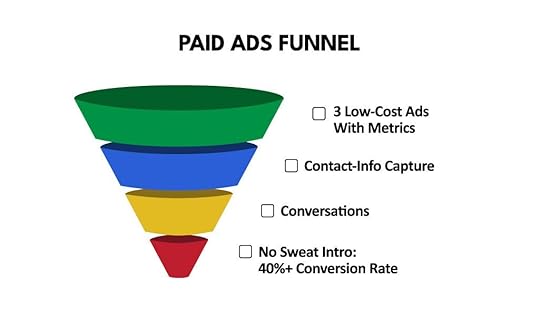
Funnel Checklist
Top: I run three ads at a time on a minimal budget. I am constantly checking my ad metrics, revising ads and amplifying those that are working best.
Middle: I capture client contact info through form submissions or retargeting pixels.
Low-middle: I move leads into conversations through email or sell-by-chat strategies.
Bottom: I’m using a consultative sales process to convert at least 40 percent of appointments from paid ads into clients.
Just Start Marketing!
You’re going to have questions, I know. Stuff like:
“Do I have to do paid ads? Even the checklist looks complicated.”
And, “Why do I have to do so much? I just wanna coach!”
And, “Where do I even start with all this?”
I get it. It looks overwhelming.
But a mentor breaks this all down into actionable steps, makes it simple and even gives you stuff to copy and paste.
You don’t need to be good at marketing to start marketing.
I’ve created a complete checklist package for gym owners: everything you need to do to reach $100,000+ in annual income. To get it, send me a DM on Facebook.
The post The Funnel Audit: Your Essential Marketing Checklist appeared first on Two-Brain Business.
April 29, 2025
The Gym Owner’s Checklist for Hitting $100,000+ Annual Income
What if you had a checklist that contained everything you had to do to build a great gym business and earn more than $100,000 per year?
That checklist now exists.

I spent the last six months distilling more than a decade of gym ownership into a 12-page document that will guide you to evaluate key aspects of your business and then take clear steps to improve your metrics.
Business ownership can be complicated, and gym owners tend to get overwhelmed by all the things they must do. But breaking things down into a manageable checklist gives you a way to pick the big problem apart and start making progress.
Yes, the checklist is long, but each item is manageable. Take action, tick a box and then move on to the next line. If you do this, you’ll build incredible momentum, and your gym will grow fast.
I’m going to give you a quick preview of the checklist, but if you want the whole package right now, send me a DM on Facebook and request it. I’ll deliver it to you ASAP so you can get moving.
Every Gym Owner’s Essential To-Do List
The checklist booklet is broken down into six sections, with a ratings scale for you at the beginning. You can literally compare your gym metrics to the numbers in the book to determine which area of your business you need to improve first.
I want you to know exactly where we get the numbers we present and why I can confidently stand behind the checklists.
For the last five years, Two-Brain Business has conducted a massive data-collection effort. We analyze metrics from our 1,000 clients, we survey gym owners around the world, and we get mountains anonymized data from software providers such as Wodify. It’s the biggest gym data set in the world, and we dig deep into it. We publish our analysis every year in our “State of the Industry” report.
This extensive ongoing research allows us to say, “This is exactly what you need to do to build a strong, profitable business.”
It also allows us to say, “You don’t need to do that,” “This tactic worked once in 2021” and “That’s BS. Ignore it.”
To show you what the checklist is all about, I’ll give you one example from each section:
Get more clients—I have a referral funnel generating leads consistently.Average revenue per member—I have increased my rates within the last three years.Length of engagement—I reach out to former clients at least three times after they leave.Effective hourly rate—I delegate lower-value roles and measure staff performance.Staff—I have a staff onboarding plan.Finance—I use a P&L or another financial tool to guide decisions for my business.
Do you do all six of those things?
If you do, good for you! Now it’s time to start checking more boxes (DM me for the plan!).
If you aren’t doing these things, you know what to work on today.
Checklists for the Win
Let’s face it: Most gym owners are first-time entrepreneurs, and we don’t know anything about business. We get overwhelmed by the nuts and bolts of business and tell ourselves “if I coach better classes, that’s gonna save my gym.”
That’s just not true. I discovered this personally, and the sooner you realize it, too, the sooner you can start growing your gym—because nobody is coming to do it for you.
I want to help you become a real entrepreneur—a CEO. I want you to get better results for clients, create careers for staff members and improve your own life. You deserve it! Your starting point: My new checklist for gym owners.
Request the guide, evaluate your business and check some boxes. Then take action and add more checkmarks. If you do that on repeat, your business will grow—I guarantee it.
And if you’re overwhelmed by my general list and don’t know where to start, don’t worry. A mentor can help you analyze your unique business and make a detailed plan to improve it. They’ll provide done-for-you resources to reduce drag, and they’ll supply accountability so you get the work done fast.
To hear more about the accelerated plan to improve your business with a mentor’s help, book a call here.
The post The Gym Owner’s Checklist for Hitting $100,000+ Annual Income appeared first on Two-Brain Business.
April 28, 2025
Want To Earn $100K From Your Gym? Start With This Checklist
To watch this episode on YouTube, click here.
The post Want To Earn $100K From Your Gym? Start With This Checklist appeared first on Two-Brain Business.
April 25, 2025
Semi-Private Training Is Not a Mini-WOD (For Real)
We need to clear something up today:
Semi-private training is not a group session in which about four people do versions of the same workout, with a coach providing on-the-spot modifications.
That is small-group training—and it is not as valuable as semi-private training.

Semi-private training is a hot topic in the fitness world because it’s a high-value service that produces great results for clients and dramatically increases revenue and average revenue per member.
But many people just don’t get the concept, and various media outlets are mucking it up, too.
To cut through the confusion, I’ll lay it out in very simple terms.
Each Client Has an Individualized Program
Imagine you have four personal-training clients. You work one on one with each client. You know exactly what each one wants to accomplish and have created a complete session-by-session training plan in advance.
For example, you already know Sherry’s bad knee won’t handle squats, so you rely on hinging movements to build lower-body strength. That is already noted in her program, as are her sets, reps and loads for the next month.
You have three other PT clients who also have their very own plans. One is a runner, one wants to lose weight, and the other is a powerlifter.
Here it is:
If you take these four clients and deliver these individualized programs in the same session for a slightly reduced rate, you are providing semi-private training.
Sherry is not doing a version of Bob’s powerlifting workout.You are not modifying one programming stream on the spot to account for Sherry’s knee.There is no general “workout of the day” or “WOD” for the hour.The clients do not have to warm up together; they don’t even have to speak to each other if they don’t want to (they can, of course).
You would literally have four different clipboards with four different pre-made training plans for four different clients. And then you would simply split your attention among the four clients while delivering each client’s individualized plan.
Yes, this requires prep work and great coaching skills. That is why semi-private training sessions are generally capped at four people. If clients feel that they aren’t getting enough attention, the program’s value will plummet.
Just so we’re 100 percent clear, I’ll offer an analogy. Semi-private training is like a semi-private room in a hospital:
A doctor treats each person in the room according to that person’s specific needs. The patients share the room and the doctor but not the diagnosis, treatment plan or medicine.
In a semi-private hospital room,
SAME DEAL WITH SEMI-PRIVATE
you do not take another
patient’s medicine.
FITNESS TRAINING.
Semi-Private Training Is PT With Others Present
You cannot run an effective semi-private training program if you don’t understand that it is personal training in every way but one: The coach’s attention is split among two to four PT clients in the same session.
Clients receive a lot of attention but not as much as they would receive in a one-on-one setting. As such, semi-private rates are lower than PT rates but much higher than any group fitness rates. A group client might pay for a membership that works out to about $12-$15 a class; a semi-private training client might pay $60 or more per session.
A client will not pay $60 an hour for you to tell them to do Fran with banded pull-ups while the five other people in the group do Fran as prescribed. That is not semi-private training.
A client will pay $60 an hour for you to build and deliver a complete training program while delivering up to three other training programs at the same time.
If you want to consider adding this high-value service, you must understand the details.
For Two-Brain clients, we have a complete Semi-Private Training course to help you implement a program fast—ask your mentor.
If you don’t work with Two-Brain yet, start with the video below, then book a call to get a growth plan tailored to your business.
The post Semi-Private Training Is Not a Mini-WOD (For Real) appeared first on Two-Brain Business.
April 24, 2025
$450+ Average Revenue Per Member 5 Months After Opening!
To watch this episode on YouTube, click here.
The post $450+ Average Revenue Per Member 5 Months After Opening! appeared first on Two-Brain Business.
April 23, 2025
Semi-Private and Small-Group Training: What’s the Difference?
High-value services are an important part of a profitable gym.
Personal training is at the top of the list: It produces the best results for clients and greatly increases the gym’s average revenue per member (ARM) and revenue.
Two other high-value services top gyms are using:
Semi-private trainingSmall-group training
I get a lot of questions about the differences between these two services, both from our clients and entrepreneurs in our Gym Owners United group.
I’ll lay out the details for you below so you know how to use these services to boost your ARM.
Semi-Private Training

Here are the key details:
Semi-private training is more valuable than group and small-group training, but it should be priced below one-on-one training.
Pricing strategy: Double your current PT rate and divide by three to get your semi-private session rate. Example: $100 an hour x 2 divided by 3 = $66.66 per session per semi-private client.
Coaches can earn 33 percent of session revenue to start and eventually work their way to a max of 44 percent (4/9ths).
Huge triple win:
Clients can buy semi-private packages that give them access to individualized programming without paying PT rates.Gym owners can take in $200-$250 an hour with four clients in a session.Coaches can earn more than $60 an hour in a four-client session.Small-Group Training

Here’s what you need to know:
A potential sticking point: In our “2024 State of the Industry” report, the average class size across all Wodify gyms was 6.34 people. That means some classes in “big-group gyms” have only two or three people. This can make it very difficult to present small-group training as an option—it’s already happening by default in many gyms that sell group coaching.
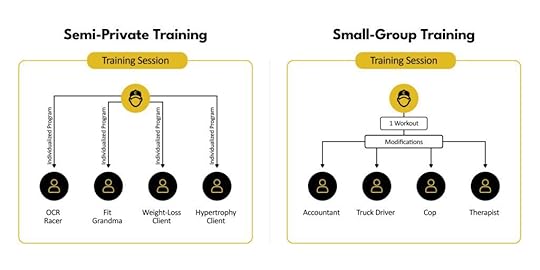
Learn More
The gyms that earn spots on our ARM leaderboards use high-value services without fail. You can’t get to $400 or $500 ARM by offering big-group fitness alone.
But if you offer group classes, develop and market a strong PT program, and complement it with semi-private or small-group training, you have a solid three-tier package that contains two high-value services. Your ARM is going to increase significantly.
So what should you do?
Two-Brain clients: We have an entire Semi-Private Coaching course. Talk to your mentor to determine if you should access the course now or prioritize another aspect of your business. If you and your mentor decide to develop a new high-value revenue stream, we have an exact plan to make it happen fast.
If you don’t work with us yet, check out this video with Two-Brain mentor Brian Bott:
Then book a call here to find out how a mentor can help you build a strong, profitable business.
The post Semi-Private and Small-Group Training: What’s the Difference? appeared first on Two-Brain Business.
April 22, 2025
Recession-Proof Revenue: How High-Value Clients Fuel Top Gyms
Quick mental exercise:
Ask yourself what would happen to your business if every client in your gym was happy to pay you $20 more a month.
What if they paid $50 more a month? How about $100 more?
Average revenue per member—ARM—is a key metric in gyms, and we track it carefully. I’m going to show you the numbers from our Top 10 gyms, but I’ll remind you that this is like looking at the leaderboard at the CrossFit Games.
Just as the best athletes show you what’s possible with fitness, the best entrepreneurs show you what’s possible in business. Don’t worry if you aren’t close to these numbers yet.
To help you move toward them, we interviewed the gym owners on this leaderboard, and I’ll give away their secrets below.
Here’s the leaderboard:
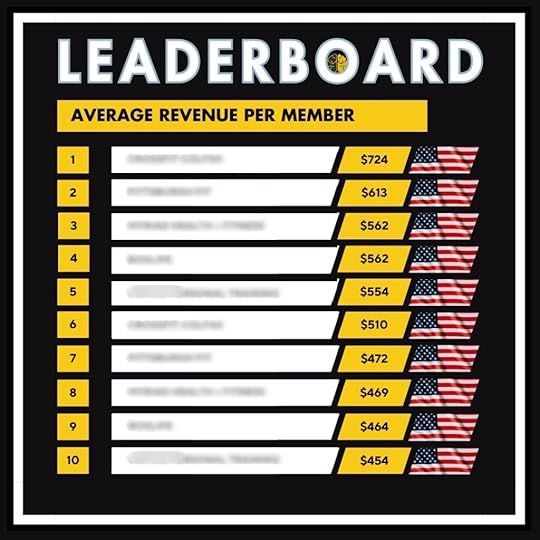
Only three gyms from our last ARM leaderboard are on this leaderboard, too. That doesn’t mean our ARM leaders fade back to low ARM after hitting a home-run in one month.
It means more Two-Brain gyms are increasing their ARM numbers and climbing into the $400-plus range.
For example, I know more and more Two-Brain gyms are introducing semi-private training—a high-value service. When that happens, their ARM goes up and they get into leaderboard territory.
Here’s proof:
One of the Top 10 gyms has been open since October 2024 and started by selling group memberships only. The owner added semi-private training after she participated in one of Two-Brain’s Office Hours sessions for Growth clients. She then booked a one-on-one call with sales coach and Two-Brain mentor Nick Habich to learn how to sell semi-private training. And now she’s in the top 10 for ARM about six months after opening her gym.
Another gym ditched group training for semi-private training in February 2024. Around that time, their ARM was $269—which is high if you’re doing group training. Now their ARM is $464 and monthly revenue is up 38 percent with 20 percent fewer clients! (Anybody who tells you that getting more clients is the way to be more profitable is not telling you the whole story.)
The cool thing about ARM is it never really goes down unless you make a big mistake as CEO—like you gut value with discounts or start offering an access-only membership. This is particularly important in times of economic uncertainty—like right now.
High-value clients are the least affected by economic uncertainty. If you focus on serving them, your gym will sail through the current storms and come out stronger on the other side.
Now, here are quotes from our leaders. You’ll note many of them contain references to high-value services such as PT and semi-private training. These are key elements in gyms with huge ARM.
Client Results
“We focus on results-driven transformation. This focus has fundamentally transformed our studio culture. We’ve become much more results oriented across all aspects of our business. Our trainers are more invested in client outcomes, our marketing highlights tangible successes, and our entire team celebrates measurable achievements.”
Retention of High-Value Clients
“We are being intentional with the members we have now, and we are focused on keeping churn low by making them feel unique.”
“We’ve recently started offering our goal reviews via an online form (with the option to also meet in person). We’re hoping this continues to help with retention and client satisfaction.”
Working on the Business, Not in It
“I’ve taken myself out of the business in terms of coaching. I’m passionate about the business and the people. I put people in place to be successful, and I empower them to take actions without my direction.”
Semi-Private Training
“We’ve been open since October and didn’t know what the value would be. All I was selling was group initially. I didn’t even ask people to sign up for semi-private. I did some Office Hours and then an additional call with (mentor) Nick Habich. … I gained confidence on selling semi-private training, and then the results boosted my confidence, too.”
“We switched our memberships from group classes to semi-private training in February 2024. We offered both for a period, but we now only offer semi-private training memberships. We received help from the Toolkit and several mentors when switching to the semi-private model. It was a huge change for us but one that we’re incredibly happy with. It has allowed us to deliver a better product, create a culture that both our members and coaches enjoy, and help our clients get what they want and need. It was a tough transition, but we’re very happy with how things are going.”
PT
“A significant factor in our ARM is our emphasis on high-ticket personal-training offerings. By allocating substantial resources and attention to developing these premium services, we’ve been able to create more personalized fitness experiences, deliver more measurable results for our clients, justify higher price points through enhanced value, and improve client retention through stronger relationships.”
“We focus on small group and one-on-one training because that is what is truly best for most people. We accept that the few who want the energy of large-group workouts will have to find that some other place, and they have many options for that.”
Prescriptive Model
“Our commitment to integrity has been fundamental to our growth. By consistently putting our clients’ needs first and focusing on delivering genuine value, we’ve strengthened our conviction during the sales process. Our client-centric approach has built trust and allowed us to confidently recommend solutions that truly benefit our members.”
Mentorship
“I haven’t done anything outside of Two-Brain—I couldn’t do this without y’all.”
“We’re doing the things that Two-Brain has suggested.”
Start With This
If you want to start increasing your ARM today, here’s the No. 1 thing you can do:
Use free consultations to tell prospective members that personal training is the best way to accomplish their goals quickly.
Some people won’t want that option—but some will. I guarantee it.
And as you add these high-value clients to your business, your ARM will improve, your revenue will grow, your retention will improve and your business will become stronger even if economic turbulence continues.
We teach clients exactly how to price, package and sell high-value services. To learn more about that, book a call here.
The post Recession-Proof Revenue: How High-Value Clients Fuel Top Gyms appeared first on Two-Brain Business.



